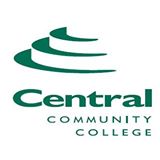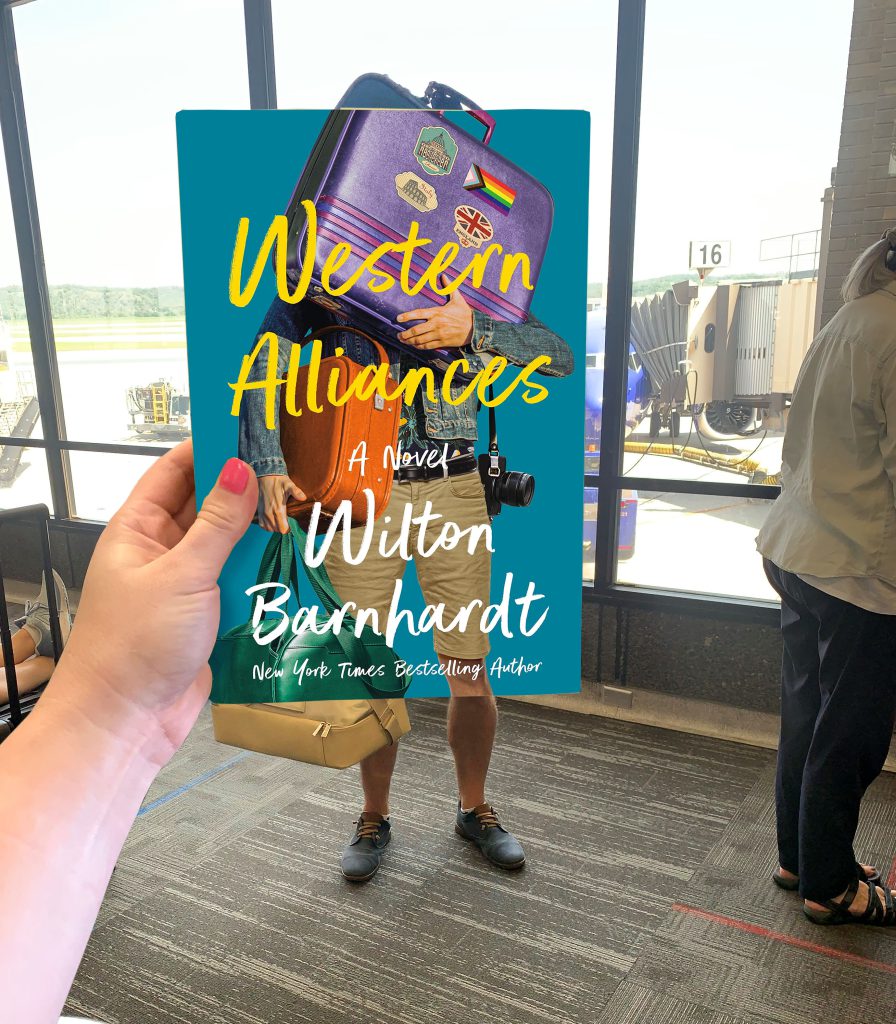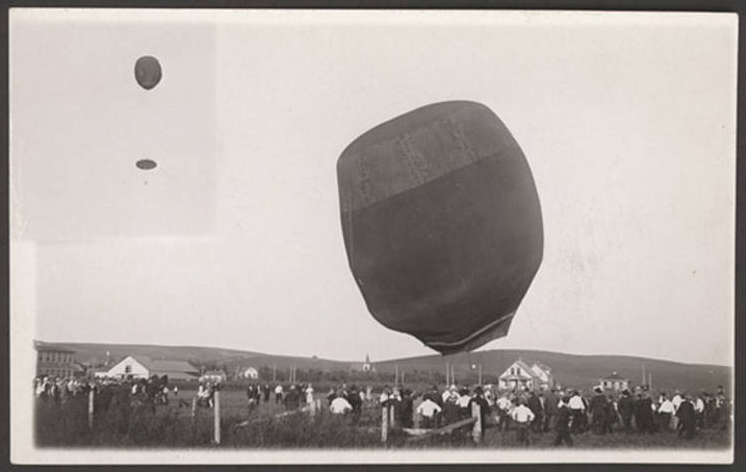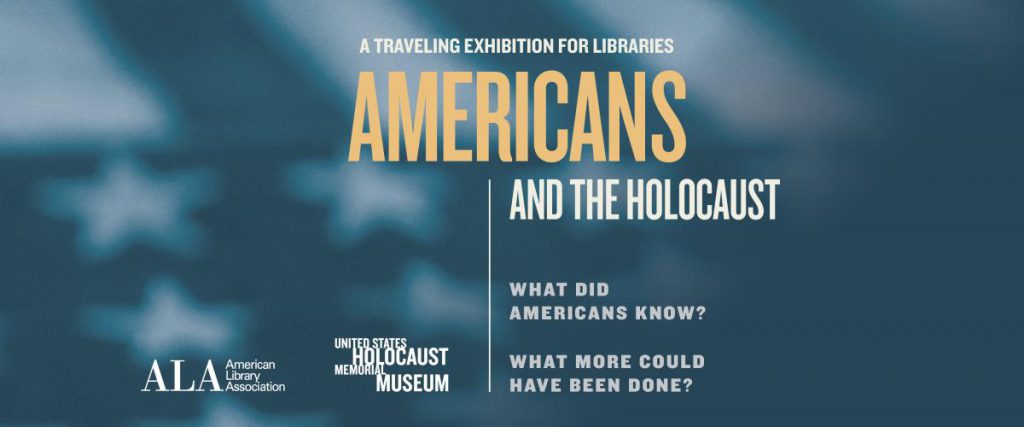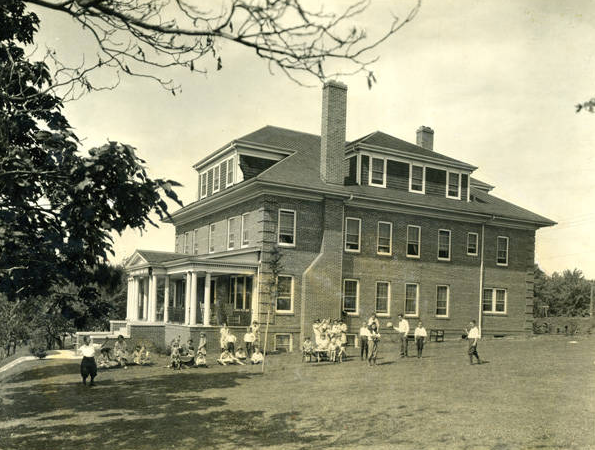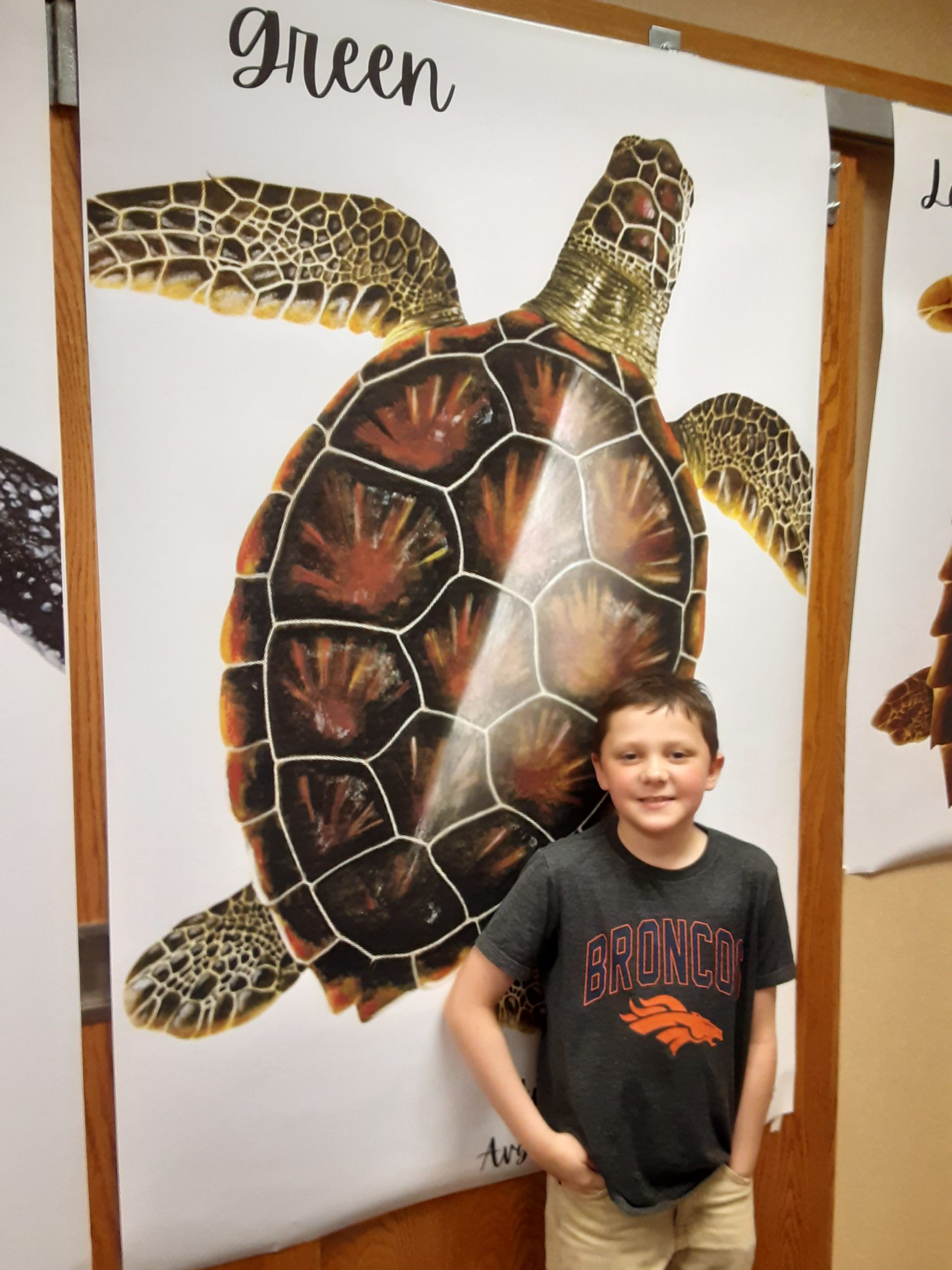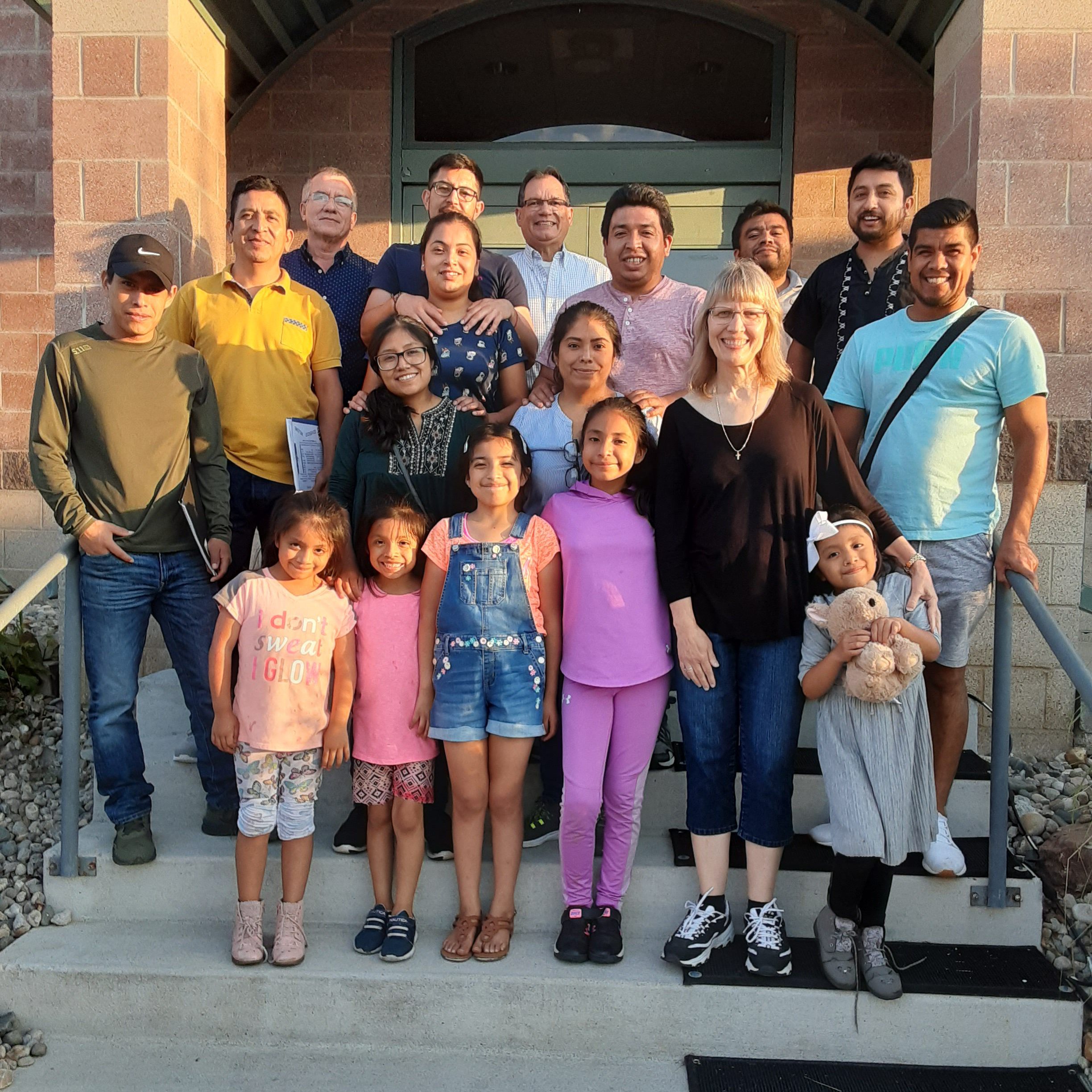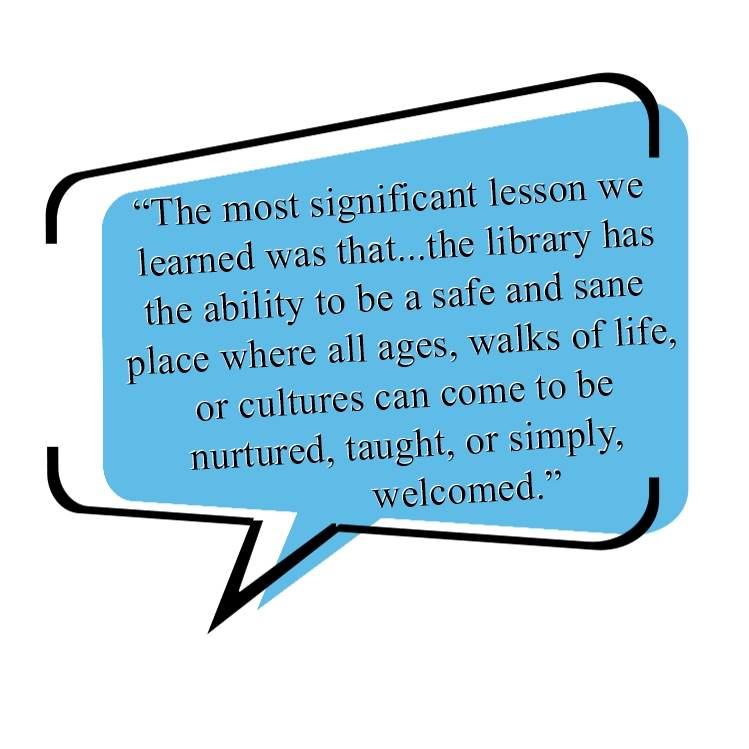Search the Blog
Categories
- Books & Reading
- Broadband Buzz
- Census
- Education & Training
- Friday Reads
- General
- Grants
- Information Resources
- Library Management
- Nebraska Center for the Book
- Nebraska Libraries on the Web
- Nebraska Memories
- Now hiring @ your library
- Preservation
- Pretty Sweet Tech
- Programming
- Public Library Boards of Trustees
- Public Relations
- Talking Book & Braille Service (TBBS)
- Technology
- Uncategorized
- What's Up Doc / Govdocs
- Youth Services
Archives
Subscribe
Category Archives: General
Throwback Thursday: Albion Public Library
Shhhh…it’s #ThrowbackThursday!
This week, we have a black and white photograph of the main room in Albion Public Library. In this image are a librarian sitting at the desk and five patrons at another table in the reading room.
This image is published and owned by the Nebraska Library Commission. This collection includes material on the history of libraries in Nebraska, mainly those built with Carnegie grants. Also included in this collection are items from the 1930s that are related to the Nebraska Public Library Commission bookmobile, as well as items that showcase history of Nebraska’s state institutions.
Check it out on the Nebraska Memories archive.
The Nebraska Memories archive is brought to you by the Nebraska Library Commission. If your institution is interested in participating in Nebraska Memories, see http://nlc.nebraska.gov/nebraskamemories/participation.aspx for more information.
Central Community College Announces LIS Classes for Fall 2023
Library and Information Services (LIS) class registration at Central Community College for Fall 2023: August 21, 2023 – December 15, 2023. Enrollment for the fall semester opens on Monday, April 10, 2023.
Classes include:
LIBR 1010 Foundations of Library and Information ServicesMarty Magee, Instructor
This course, the recommended first in the Library and Information Services curriculum, provides introductory information in multiple areas.
- Library history and organizations<
- Foundation Principles/Code of Ethics<
- Information databases and Internet usage<
Michael Straatmann, Instructor
This course includes the theories, concepts and activities integral to leading and managing 21st Century libraries and information agencies.
- Leadership principles
- Management strategies
- Policies and procedures
Patty Birch, Instructor
This capstone course is the last course in the Library and Information Services program. Students will complete 40 hours of service learning in a host library. The course also includes a review of the principal pieces of learning from the LIS program.
- Prerequisites: LIBR 1010, 2100, 2150, 2210, & 2250
New changes…Beginning Fall 2023, the LIBR 2210 Cataloging & Classification course has been
merged with the LIBR 2150 Managing Collections in Libraries & Information Agencies class. The new combined class is LIBR 2210 Develop and Organize Collections to be offered in Spring 2024. And the Library & Information Services Certificate has been reduced from 18 credit hours to a 15-credit hour program.
For more information on the Library and Information Services program, see: www.cccneb.edu/lis/
For information concerning Admissions or Registration, contact: Dee Johnson, djohnson@cccneb.edu, 402-562-1418 or Toll Free at 877-222-0780.
Grant Opportunity: High School Drone Program
If you work with high school students in your library, or know a high school in need of a drone program, check out this FAA Aircraft Pilots Workforce Development Grant Program.
The FAA is awarding up to $500,000 to multiple applicants for a total of $4,500,000 in an effort to attract future aircraft pilots, aerospace engineers, or unmanned aircraft systems operators (drone operators) in the U.S. Starting a drone pilot training program in your school or library is a great way to attract future aviation professionals!The grant application is due August 16, 2023, so think fast! Feel free to check out these drone training resources for high school age students as inspiration for your grant writing:
- Skyop: Drone Training Programs for High Schools. Reach out to them for a consultation and customized program. This program can actually result in pilot certification.
- Droneblocks Curriculum for DJI Tello Drones
- CoDroneEDU Classroom Packs from Robolink
You can also reach out to local community colleges and universities to get the most up to date drone-related curriculum, or more local resource and program referrals. I’ll stop droning on now. Happy applying!

Posted in Education & Training, General, Grants, Pretty Sweet Tech
Leave a comment
Throwback Thursday: Automobile
Happy #ThrowbackThursday from Nebraska Memories!
This week, we have a 5″ x 7″ nitrate negative of an automobile and garage owned by Wade Croft in David City, Nebraska. The car is in the process of being re-painted.
This image was created by Edith Proskovec (Boston). It is owned by the Thorpe Opera House Foundation and is part of the Boston Studio Project. The Boston Studio Collection consists of over 68,000 negatives that record life in and around David City, Nebraska from 1893 to 1979. Harvey Boston, a professional photographer in David City, owned a portrait studio business from 1893 until his death in 1927. The business was later run by his daughter Edith Boston Proskovec and then by his son-in-law Audrey Hurlbert, before being sold in 1973.
Check out the full collection on the Nebraska Memories archive.
The Nebraska Memories archive is brought to you by the Nebraska Library Commission. If your institution is interested in participating in Nebraska Memories, see http://nlc.nebraska.gov/nebraskamemories/participation.aspx for more information.
#BookFaceFriday “I’m Glad My Mom Died” by Jennette McCurdy
I’m glad it’s #BookFaceFriday!
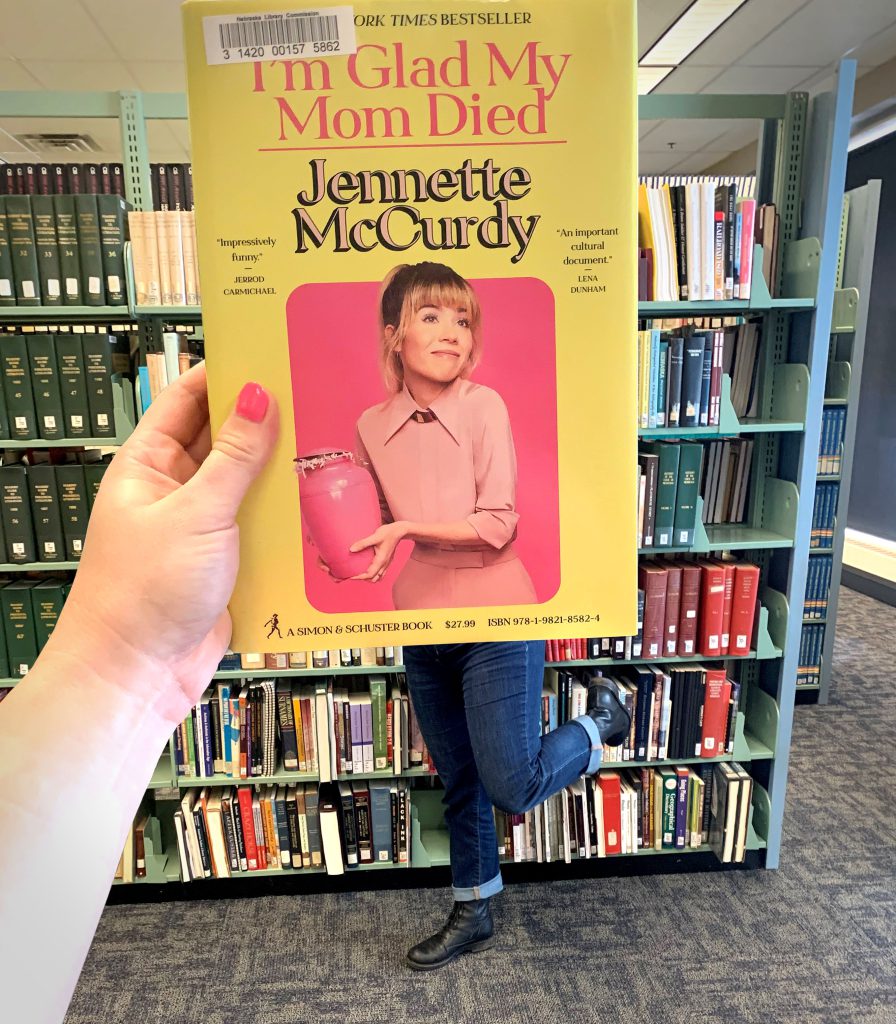
This unflinching memoir of a childhood actor makes for one great #BookFaceFriday! You might have noticed this week’s title from a post earlier this week called Book Club Spotlight. It’s a great way to get to know different titles in the collection that you might not have considered before. Like #1 New York Times Bestseller and a #1 International Bestseller, “I’m Glad My Mom Died” by Jeannette McCurdy (Simon & Schuster, 2022.) If you use our book club kit service, you know Mackenzie Marrow, our Information Services Technician! Here’s what they had to say about it “I first started the Book Club Spotlight as a way for me to get to know our collection better when I first started here at the Commission. Now it is a way for me to show off our wonderful collection and help book clubs find titles that might be hidden or they wouldn’t think they would like at first glance. When a group is trying to decide what to read next, I want the Spotlight to be a resource where they can browse through and get a real feel for what a title is about and how their group might respond to it rather than just a synopsis.”
We currently have five copies available in our Book Club Kit Collection. It’s also available as an ebook and audiobook in Nebraska OverDrive Libraries.
“McCurdy asks readers a question: When and how does one rid oneself of the cage created by others and walk freely? Her stunning debut offers fierce honesty, empathy for those that contributed to her grief, and insights into the hard-fought attachments and detachments of growing older.”
— Booklist (starred review)
Book Club Kits Rules for Use
- These kits can be checked out by the librarians of Nebraska libraries and media centers.
- Circulation times are flexible and will be based upon availability. There is no standard check-out time for book club kits.
- Please search the collection to select items you wish to borrow and use the REQUEST THIS KIT icon to borrow items.
- Contact the Information Desk at the Library Commission if you have any questions: by phone: 800/307-2665, or by email: Information Services Team
Find this title and many more through Nebraska OverDrive! Libraries participating in the Nebraska OverDrive Libraries Group currently have access to a shared and growing collection of digital downloadable audiobooks and eBooks. 189 libraries across the state share the Nebraska OverDrive collection of 21,696 audiobooks, 35,200 eBooks, and 3,964 magazines. As an added bonus it includes 130 podcasts that are always available with simultaneous use (SU), as well as SU ebooks and audiobook titles that publishers have made available for a limited time. If you’re a part of it, let your users know about this great title, and if you’re not a member yet, find more information about participating in Nebraska Overdrive Libraries!
Love this #BookFace & reading? Check out our past #BookFaceFriday photos on the Nebraska Library Commission’s Facebook page!
Throwback Thursday: Hot Air Balloon
Let’s get carried away with this week’s #ThrowbackThursday!
This black and white photographic postcard was created by John Nelson (1864-1942). He was born in Harestad, Sweden in 1864. He came to Nebraska with his parents when he was 17. His work tells the story of small town life in Nebraska during the beginning of the 20th century. This image published and owned by History Nebraska.
Check out all of the Nebraska related materials on the Nebraska Memories archive!
The Nebraska Memories archive is brought to you by the Nebraska Library Commission. If your institution is interested in participating in Nebraska Memories, see http://nlc.nebraska.gov/nebraskamemories/participation.aspx for more information.
2023 NLS Summer Reading Author Talk: Jenny Torres Sanchez
Join us on Zoom for an exciting author talk with Jenny Torres Sanchez, author of We Are Not from Here!
Jenny Torres Sanchez writes children’s and young adult fiction that has been a finalist for the Pura Belpre Award and included on the American Library Association’s annual list of Best Fiction for Young Adults. Her book We Are Not from Here vividly captures the treacherous journey of three teenagers who cross from Guatemala through Mexico to the United States in search of a better life.
This event is specially designed for YA, but all are welcome.
- Thursday, August 3 at 7:00 pm EDT
- Webinar registration: Author Talk – Jenny Torres Sanchez
For more information:
Annette Hall
402-471-4033
annette.hall@nebraska.gov
#BookFaceFriday “The Meaning of Names” by Karen Gettert Shoemaker
It’s a dark and stormy #BookFaceFriday!
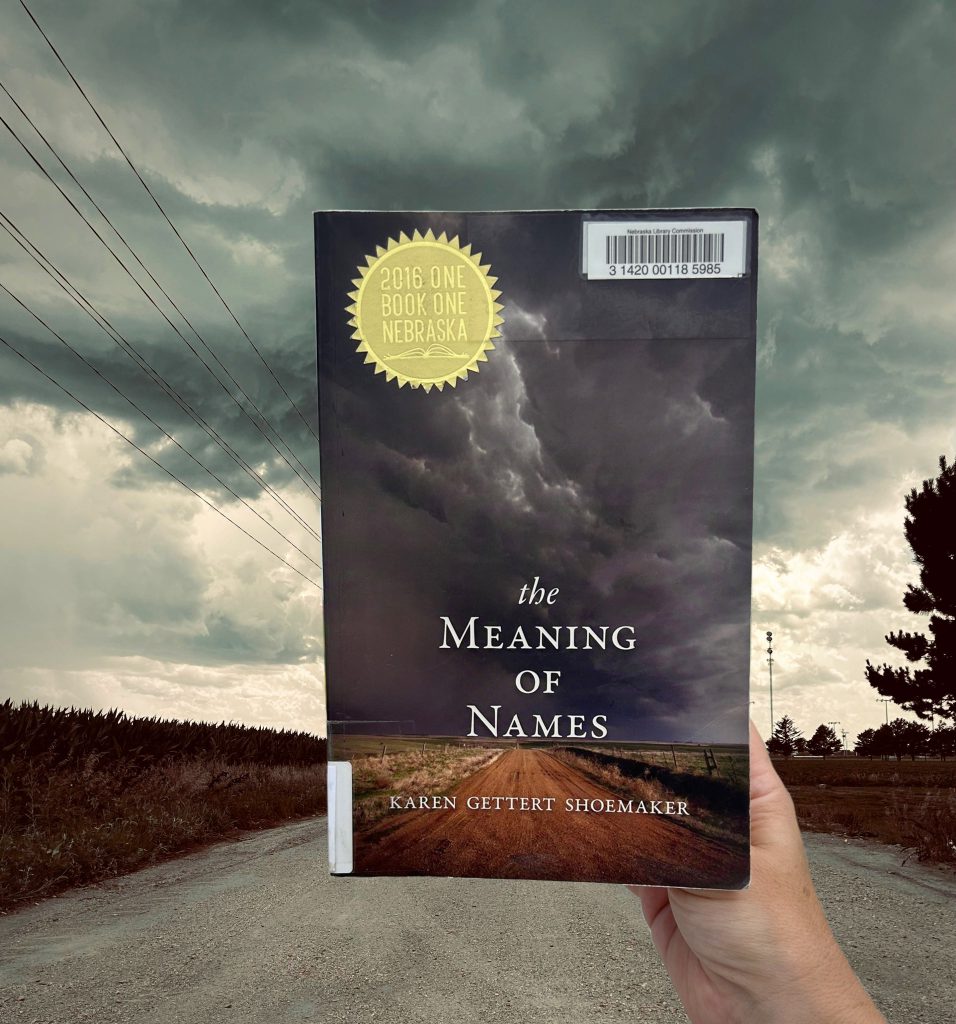
This week’s #BookFaceFriday is a past One Book One Nebraska selection, we keep all past OBON book club kits, so if you haven’t read them all now’s your chance! “The Meaning of Names” by Karen Gettert Shoemaker (Red Hen Press, 2015), was the 2016 selection and is a great read for book clubs! This title is also available as an ebook in Nebraska OverDrive Libraries. You can find all of the OBON titles on our Book Club Kits page; just search “One Book One Nebraska” in the Keyword search box. Add it to your to-be-read list today!
“The Meaning of Names… explores exactly that – what message does a simple name convey? How is that meaning twisted during times of trial? Shoemaker presents readers with a simple, realistic cast of characters, a heart-rending story of endurance, and reminds us that both prejudice and forgiveness take many forms.”
— Historical Novel Society
Book Club Kits Rules for Use
- These kits can be checked out by the librarians of Nebraska libraries and media centers.
- Circulation times are flexible and will be based upon availability. There is no standard check-out time for book club kits.
- Please search the collection to select items you wish to borrow and use the REQUEST THIS KIT icon to borrow items.
- Contact the Information Desk at the Library Commission if you have any questions: by phone: 800/307-2665, or by email: Information Services Team
Find this title and many more through Nebraska OverDrive! Libraries participating in the Nebraska OverDrive Libraries Group currently have access to a shared and growing collection of digital downloadable audiobooks and eBooks. 189 libraries across the state share the Nebraska OverDrive collection of 21,696 audiobooks, 35,200 eBooks, and 3,964 magazines. As an added bonus it includes 130 podcasts that are always available with simultaneous use (SU), as well as SU ebooks and audiobook titles that publishers have made available for a limited time. If you’re a part of it, let your users know about this great title, and if you’re not a member yet, find more information about participating in Nebraska Overdrive Libraries!
Love this #BookFace & reading? Check out our past #BookFaceFriday photos on the Nebraska Library Commission’s Facebook page!
Apply to bring ‘Americans and the Holocaust’ Traveling Exhibition to Your Library
For more grants like this one, check out the NLC’s Grant Opportunities for Nebraska Libraries at http://nlc.nebraska.gov/grants/index.aspx
ALA’s Public Programs Office, in collaboration with the United States Holocaust Memorial Museum (USHMM), invites public and academic libraries to apply to host Americans and the Holocaust, a traveling exhibition that examines the motives, pressures and fears that shaped Americans’ responses to Nazism, war and genocide in Europe during the 1930s and 1940s.The Americans and the Holocaust traveling exhibition toured libraries across the United States from October 2021 to January 2024, and it is extending its tour to another 50 libraries between June 2024 to July 2026. The 1,100-square-foot traveling exhibition is based on the exhibition that opened in April 2018 at the USHMM in Washington, DC.
Drawing on a remarkable collection of primary sources from the 1930s and ’40s, the exhibition examines how individuals and groups in American society — from the government, military, nonprofit organizations, media, and general public — responded to Nazism and genocide. It aims, like all of the USHMM’s exhibitions, to motivate audiences to think critically about the history as individual citizens, as a country, and as members of a global community. The Museum and ALA PPO hope to challenge people to not only ask “what would I have done?” but also, “what will I do?”
Selected libraries will receive:
- The 1,100-square-foot exhibition on loan for five to six weeks;
- A $3,000 allowance to support public programs;
- Expenses paid for a library staff member to attend an orientation workshop (May 15-16, 2024 ) at the Museum in Washington, D.C.; and
- Publicity materials, programming resources, ongoing support from the Museum and the ALA, and more.
Grantees must meet minimum programming and reporting requirements. See the project guidelines for details.
Apply online at https://www.ala.org/tools/programming/USHolocaustMuseum/
Application deadline for the 2024-2026 Tour is October 14, 2023.
Americans and the Holocaust was made possible by the generous support of lead sponsor Jeannie & Jonathan Lavine. Additional major funding was provided by the Bildners — Joan & Allen z”l, Elisa Spungen & Rob, Nancy & Jim; and Jane and Daniel Och. The Museum’s exhibitions are also supported by the Lester Robbins and Sheila Johnson Robbins Traveling and Special Exhibitions Fund, established in 1990.
To be notified about future grants and opportunities from ALA’s Public Programs Office, sign up for ALA’s Programming Librarian newsletter at https://programminglibrarian.org/about/get-our-enewsletter
Posted in General, Programming
Leave a comment
Throwback Thursday: Telephone Office
Listen up! It’s #ThrowbackThursday!
In 1882, the telephone exchange owned by the Nebraska Telephone Company was established in Fairmont. By 1884, 30 instruments were in use in Fairmont, with the central office attending to an average of 300 calls per day. This picture was taken in 1923 with Lawava Abrams, Mae Crooker McMahon, May Walker, Bess Storm and Alice Crooker Peters.
During this time, there was also an Independent Telephone company and the rivalry between the two companies was high. Cedar Hill Telephone Company and Scott Telephone Company were also vying for a part of the telephone interest. The Nebraska Telephone Company was bought out by Lincoln Telephone and Telegraph Company on January 22, 1912.
This black and white photograph is published and owned by Fairmont Public Library. In partnership with the Fillmore County Historical Society, photographs depicting the history of Fillmore County were digitized. Included in this collection are images of local businesses, schools, churches, and the Fairmont Army Airfield, which was used during World War II.
See this collection and many more on the Nebraska Memories archive.
The Nebraska Memories archive is brought to you by the Nebraska Library Commission. If your institution is interested in participating in Nebraska Memories, see http://nlc.nebraska.gov/nebraskamemories/participation.aspx for more information.
2023 NLS Summer Reading Author Talk: Kwame Alexander
Join us on Zoom for an exciting author talk! Kwame Alexander is a New York Times best-selling author for children of all ages, as well as a poet, educator, and recipient of the Newbery Medal.
This event is specially designed for YA and middle grades, but all are welcome.
- Thursday, July 27 at 7:00 pm EDT
- Webinar registration: Author Talk – Kwame Alexander
Mark your calendar for the last upcoming event in the NLS Summer Reading program:
- Thursday, August 3 at 7:00 pm EDT: Author Talk (YA) – Jenny Torres Sanchez, We Are Not From Here
For more information:
Annette Hall
402-471-4033
annette.hall@nebraska.gov
#BookFaceFriday “The Lake House” by Sarah Beth Durst
You might have to leave the light on for this #BookFaceFriday!
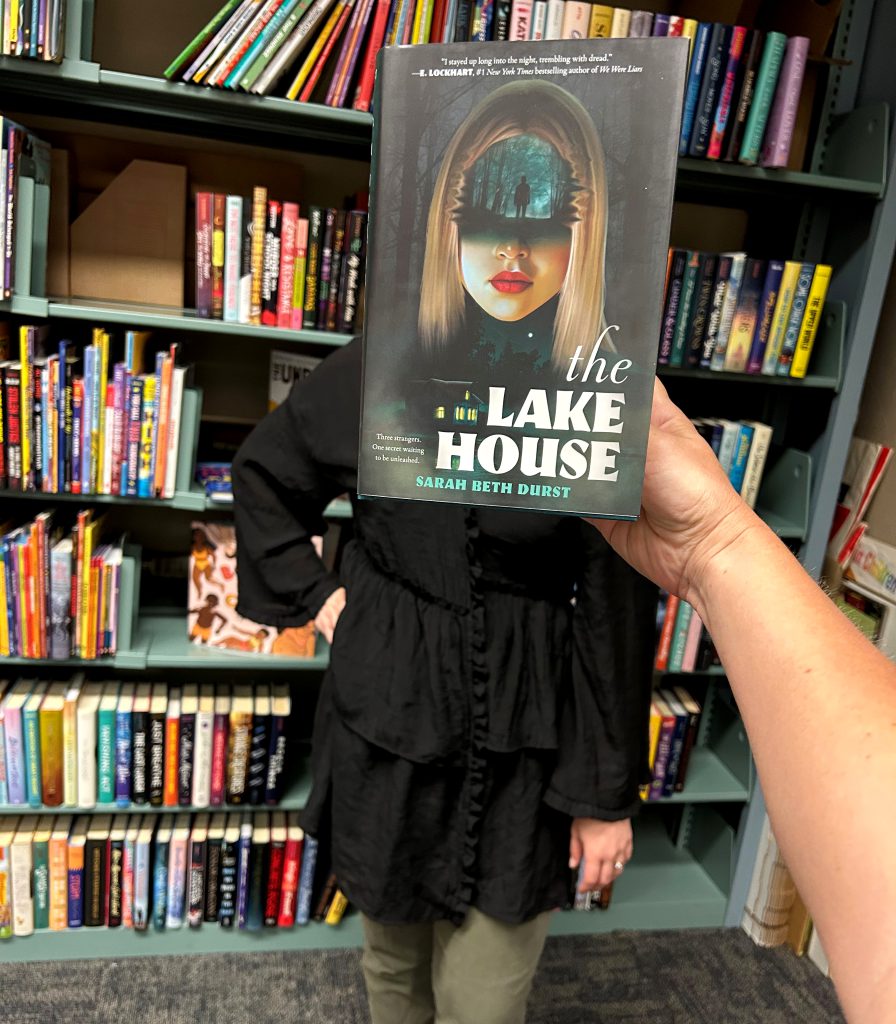
Summer Camp isn’t all it’s cracked up to be in this week’s #BookFace! “The Lake House” by Sarah Beth Durst (HarperTeen, 2023) is a nail biting thriller for teens, and it’s all set at a sleep away camp. Perfect for readers who like something a little scary, described as “Yellowjackets meets One of Us Is Lying.“
“Nail-biting and atmospheric, The Lake House explores how secrets keep people apart—and the power of female friendships. Reyva, Mariana, and especially Claire are characters you can’t stop rooting for, even as every obstacle they surmount is replaced by a bigger one. I read it every time I had a spare second, and a lot of times when I didn’t.”
— April Henry, New York Times bestselling author
This title comes from our large collection of children’s and young adult books sent to us as review copies from book publishers. When our Children and Young Adult Library Services Coordinator, Sally Snyder, is done with them, the review copies are available for the Library System Directors to distribute to school and public libraries in their systems.
Love this #BookFace & reading? Check out our past #BookFaceFriday photos on the Nebraska Library Commission’s Facebook page!
Posted in Books & Reading, General, Youth Services
Tagged Book Covers, bookface, bookfacefriday, Reading, Sarah Beth Durst, The Lake House, Thriller, YA books
Leave a comment
Throwback Thursday: Rotunda – Douglas County Court House
Happy #ThrowbackThursday from Nebraska Memories!
This week’s throwback features a color postcard with an interior view of the Douglas County Courthouse in Omaha, Nebraska.
In July of 1908, Omaha architect, John Latenser Sr. was hired to design Omaha’s third courthouse. Architectural plans were completed in 1909 and the Columbus, Indiana, firm of Caldwell & Drake were hired to construct it. The atrium above the rotunda shown in this image rises 110 feet and is topped by a large skylight. The courthouse opened on October 1, 1912.
This image is published and owned by Omaha Public Library. Items in this collection include early Omaha-related maps dating from 1825 to 1922, as well as over 1,100 postcards and photographs of the Omaha area.
If you or someone you know likes history, especially Nebraska History, check out the Nebraska Memories archive! It’s a cooperative project to digitize Nebraska-related historical and cultural materials and make them available to researchers of all ages.
The Nebraska Memories archive is brought to you by the Nebraska Library Commission. If your institution is interested in participating in Nebraska Memories, see http://nlc.nebraska.gov/nebraskamemories/participation.aspx for more information.
2023 NLS Summer Reading Author Talk: Annette Bay Pimentel and Jennifer Keelan-Chaffins
Join us on Zoom for an exciting author talk with Annette Bay Pimentel, author of All the Way to the Top: How One Girl’s Fight for Americans with Disabilities Changed Everything!
Author Annette Bay Pimentel will read from her picture book and be joined by the heroine of her story, Jennifer Keelan-Chaffins.
This event is specially designed for K-5th grade, but all are welcome.
- Saturday, July 22 at 1:00 pm EDT
- Webinar registration: Author Talk – Annette Bay Pimentel and Jennifer Keelan-Chaffins
Mark your calendars for the following events happening this summer as part of the NLS Summer Reading program:
- Thursday, July 27 at 7:00 pm EDT: Author Talk (YA and Middle Grades) – Kwame Alexander, The Crossover
- Thursday, August 3 at 7:00 pm EDT: Author Talk (YA) – Jenny Torres Sanchez, We Are Not From Here
For more information:
Annette Hall
402-471-4033
annette.hall@nebraska.gov
#BookFaceFriday “The Rachel Incident” by Caroline O’Donoghue
Don’t turn your back on #BookFaceFriday!
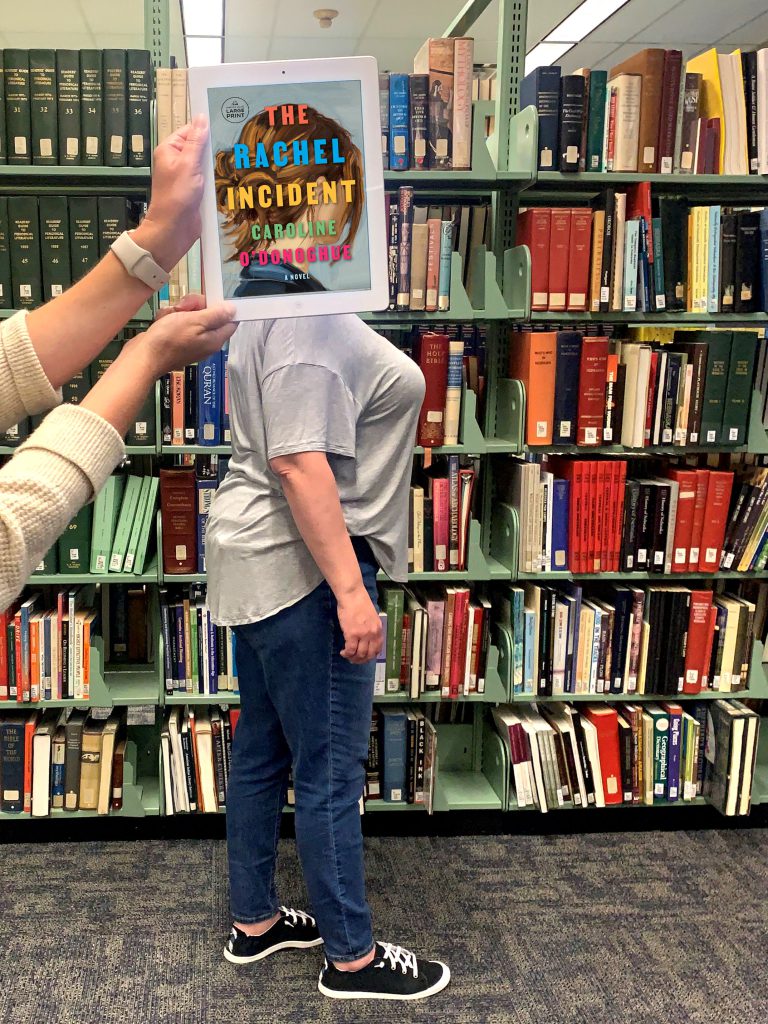
Life (and love) can get complicated, but finding your next great read on Nebraska Overdrive Libraries doesn’t have to be! Find all the new book in our “Latest 500 titles added” collection. One of the titles is “The Rachel Incident” by Caroline O’Donoghue (Diversified Publishing, 2023.) This funny novel about friendship and love in Ireland is available as both an eBook and an Audiobook.
“A college student gets caught in the middle of a friend’s romance in this delightful Irish novel…. This deliciously complex set of entanglements lays the groundwork for the novel… and bring to mind the gossipy 19th-century novels Dr. Byrne might teach in class. But its true joys lie in the tremendously witty characters and their relationships: The real love story of this novel is not between James and Dr. Byrne, or Rachel and her own paramour, but between Rachel and James, whose codependent glee in each other’s company will remind many readers of their own college friendships, especially those between women and queer men…. Sensational.”
―Kirkus (Starred Review)
Find this title and many more through Nebraska OverDrive! Libraries participating in the Nebraska OverDrive Libraries Group currently have access to a shared and growing collection of digital downloadable audiobooks and eBooks. 189 libraries across the state share the Nebraska OverDrive collection of 21,696 audiobooks, 35,200 eBooks, and 3,964 magazines. As an added bonus it includes 130 podcasts that are always available with simultaneous use (SU), as well as SU ebooks and audiobook titles that publishers have made available for a limited time. If you’re a part of it, let your users know about this great title, and if you’re not a member yet, find more information about participating in Nebraska Overdrive Libraries!
Love this #BookFace & reading? Check out our past #BookFaceFriday photos on the Nebraska Library Commission’s Facebook page!
Throwback Thursday: Badminton Game
It’s time for another #ThrowbackThursday from Nebraska Memories!
This week, we have a 9 1/2″ x 7 1/2″ black and white photograph of a summer badminton game at the Nebraska Children’s Home during the 1920s.
This image is published and owned by the Nebraska Children’s Home Society. The founders of the Nebraska Children’s Home believed that every child deserved a family. NCHS offered support and assistance to parents committed to keeping their family together, and provided foster and adoptive homes for children who could not stay with their families. The agency has never charged fees for adoption services and still today relies primarily on private donations to fund its services. NCHS has committed itself best practices based on the welfare of a child.
See this collection and many more on the Nebraska Memories archive.
The Nebraska Memories archive is brought to you by the Nebraska Library Commission. If your institution is interested in participating in Nebraska Memories, see http://nlc.nebraska.gov/nebraskamemories/participation.aspx for more information.
ARPA Report – St. Edward Public Library
St. Edward Public Library used ARPA funds to support the community!
Several areas of the community, along with the library, were impacted by the COVID-19 pandemic. The library’s project targeted specific areas such as infection control, library organization, support for local students, support for homeschooling families, stress relief, and support for Hispanic families.
School administration did not feel it was safe for elementary students to take field trips. So, the library provided several educational programs. These programs covered topics such as pet care, habitats of exotic animals, raptor recovery, wildlife and water conservation within our state, sea turtles, penguins, ocean life, prehistoric oceans, and an art class taught by a local artist. Adult painting classes were also hosted in an attempt to relieve some of the anxiety and stress that resulted due to the pandemic.
Due to this increase in programming, additional organization space was needed. Some of the funds were used to add another file cabinet to the library’s workroom. Also, the library purchased an air purifier to improve infection control.
During this time, the community saw an increase in homeschooling. To aid in this transition, the library added a Homeschooling Resource section. These materials included books from Around the World geography curriculum, Imagination Station history curriculum, Ocean Anatomy, Farm Anatomy, Nature Anatomy, Food Anatomy, and Homeschooling Tips and Ideas for parents.
Lastly, some of the Hispanic members of the community struggled with the language barrier. This lead to problems obtaining services and health care. Some of the ARPA funds were used to obtain bilingual books and materials for the library’s conversational ESL class.
The library has seen success through its projects. Programs for the local students were well attended and some of the teachers have expanded the programs into their classrooms. The library is also working with the local school to provide during and after school sessions.
The homeschooling parents have formed friendships and a support system for each other. There is talk about forming a co-op to bring the kids together for some classes and experiences. Materials for the homeschooling families will continue to be added to the library’s collection and space for the co-op will be provided.
The library’s adult patrons have expressed appreciation for its stress relieving programs. The library is also in the process of scheduling more adult and senior programs.
Local businesses and services, along with the school, have indicated that the library’s English classes for the Hispanic community members have been helping with communication. The Boone County Foundation has expressed interest in helping the continuation of the ESL classes.
The biggest lesson learned was that the library has that ability to be safe space where all are able to come to be nurtured, taught, or just welcomed.
______________________________________________________________________________
The American Rescue Plan Act (ARPA) is result of the federal stimulus bill passed by Congress. The Nebraska Library Commission received a one-time award of $2,422,166. A portion of this funding has been allocated for three projects: Formula based grant program, NLC Library Improvement Grants, and NLC Youth Grants for Excellence.
This project is supported in part by the Institute of Museum and Library Services under the provisions of the Library Services and Technology Act as administered by the Nebraska Library Commission.
For more information about the 2021 American Rescue Plan, visit www.nlc.nebraska.gov/grants/arpa/index.aspx
2023 NLS Summer Reading Author Talk: Celia C. Perez
Join us on Zoom for an exciting author talk with Celia C. Perez, author of The First Rule of Punk!
This event is specially designed for middle grades, but all are welcome.
- Tuesday, July 11 at 7:00 pm EDT
- Webinar registration: Author Talk – Celia C. Perez
Mark your calendars for the following events happening this summer as part of the NLS Summer Reading program:
- Saturday, July 22 at 1:00 pm EDT: Author Talk (K-5th Grade) – Annette Bay Pimentel and Jennifer Keelan-Chaffins, All the Way to the Top: How One Girls’ Fight for Americans with Disabilities Changed Everything
- Thursday, July 27 at 7:00 pm EDT: Author Talk (YA and Middle Grades) – Kwame Alexander, The Crossover
- Thursday, August 3 at 7:00 pm EDT: Author Talk (YA) – Jenny Torres Sanchez, We Are Not From Here
For more information:
Annette Hall
402-471-4033
annette.hall@nebraska.gov

